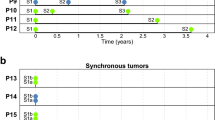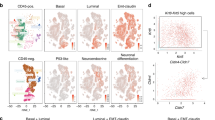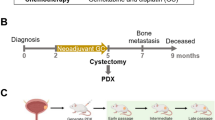Abstract
Cell cultures were made from 18 human bladder tumours. Three cell lines were maintained for seven transfer generations, but all had a “fibroblastic” morphology and a normal diploid karyotype. A fourth line has been maintained for over 80 transfer generations. This was derived from a well differentiated papillary tumour of bladder. Morphologically the light and electron microscopic structure of the cells resembled that of bladder tumours. The cells formed tumour nodules, with a similar structure, when transplanted into hamster cheek pouches. There is a stem line chromosome number of 48. Karyotypes of 60% of the stem line cells had one extra chromosome in Group C and one in Group D.
This is a preview of subscription content, access via your institution
Access options
Subscribe to this journal
Receive 24 print issues and online access
$259.00 per year
only $10.79 per issue
Buy this article
- Purchase on Springer Link
- Instant access to full article PDF
Prices may be subject to local taxes which are calculated during checkout
Similar content being viewed by others
Rights and permissions
About this article
Cite this article
Rigby, C., Franks, L. A Human Tissue Culture Cell Line from a Transitional Cell Tumour of the Urinary Bladder: Growth, Chromosome Pattern and Ultrastructure. Br J Cancer 24, 746–754 (1970). https://doi.org/10.1038/bjc.1970.89
Issue Date:
DOI: https://doi.org/10.1038/bjc.1970.89
This article is cited by
-
Standardization of Grocott’s methenamine (hexamine) silver method for glycogen demonstration in liver tissue
Histochemistry and Cell Biology (2023)
-
Repression of the PRELP gene is relieved by histone deacetylase inhibitors through acetylation of histone H2B lysine 5 in bladder cancer
Clinical Epigenetics (2022)
-
The human TRAM1 locus expresses circular RNAs
Scientific Reports (2021)
-
Increased endocytosis of magnetic nanoparticles into cancerous urothelial cells versus normal urothelial cells
Histochemistry and Cell Biology (2018)
-
Targeting Deficiencies in the TLR5 Mediated Vaginal Response to Treat Female Recurrent Urinary Tract Infection
Scientific Reports (2017)



